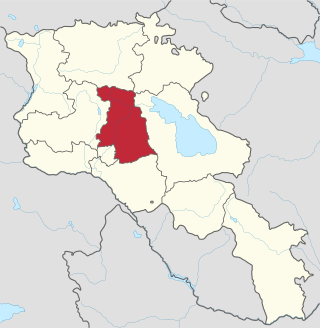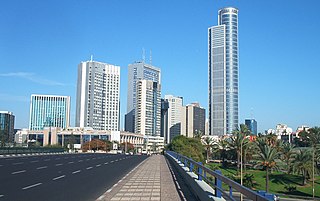Related Research Articles

Kotayk, is a province (marz) of Armenia. It is located at the central part of the country. Its capital is Hrazdan and the largest city is Abovyan. It is named after the Kotayk canton of the historic Ayrarat province of Ancient Armenia.

Lori, is a province (marz) of Armenia. It is located in the north of the country, bordering Georgia. Vanadzor is the capital and largest city of the province. Other important towns include Stepanavan, Alaverdi, and Spitak. It is home to the UNESCO World Heritage Sites of Haghpat and Sanahin monasteries and the well-preserved Akhtala monastery, where Armenians, Georgians, and Greeks make an annual pilgrimage on September 20–21.

Tavush is a province of Armenia located at the northeast of Armenia, bordered by Georgia from the north and Azerbaijan from the east. Internally, Tavush borders the Gegharkunik Province from the south, Kotayk Province from the southwest, and the Lori Province from west. The capital and largest city of the province is the town of Ijevan.

The Kimberley Process Certification Scheme (KPCS) is the process established in 2003 to prevent "conflict diamonds" from entering the mainstream rough diamond market by United Nations General Assembly Resolution 55/56 following recommendations in the Fowler Report. The process was set up "to ensure that diamond purchases were not financing violence by rebel movements and their allies seeking to undermine legitimate governments."

Lev (Levi) Leviev is an Israeli diamond magnate, investor and philanthropist. Leviev was the Chairman and majority shareholder of Africa Israel Investments, a diversified conglomerate, between 1997-2018. Leviev lived in Israel between 1971-2007 and moved to reside in London. He is a noted philanthropist for Chabad Lubavitch causes in Eastern Europe and Israel. In 2018, Leviev had a net worth of US$1 billion according to Forbes.

Abovyan or Abovian, is a town and urban municipal community in Armenia within the Kotayk Province. It is located 16 kilometres northeast of Yerevan and 32 kilometres southeast of the province centre Hrazdan. As of the 2011 census, the population of the town is 43,495, down from 59,000 reported at the 1989 census. Currently, the town has an approximate population of 44,900 as per the 2020 official estimate.

The Diamond industry of Israel is an important world player in producing cut diamonds for wholesale. In 2010, Israel became the chair of the Kimberley Process Certification Scheme. As of 2016, cut diamonds constituted 23.2% of Israel's total exports and they were the country's biggest export product, amounting to 12% of the world's production.

Lodewyk van Bercken was a mid- to late-15th century Flemish jeweller and diamond cutter, renowned in the industry for inventing the scaif. The device revolutionized the diamond cutting industry and contributed to increased popularity of diamonds.

Nor Hachn, is a town and urban municipal community in the Kotayk Province of Armenia, founded in 1953. The town is located on the right bank of Hrazdan River, to the west of the Arzni canyon, on the immediate proximity of the Arzni-Shamiram canal.

Byureghavan, is a town and urban municipal community in the Kotayk Province of Armenia. It is located 16 kilometres northeast of Yerevan, and 25 kilometres south of the provincial center Hrazdan. It covers an area of 4 square kilometres. The rural communities of Nurnus and Arzni form the northern and southern borders of the town respectively. As of the 2011 census, the population of the town is 9,513. Currently, the town has an approximate population of 8,300 as per the 2016 official estimate.
Lazare Kaplan International Inc. (LKI) is a diamond manufacturing and distribution company based in New York City. The Chairman of the Board of Directors is Maurice Tempelsman. The first LKI was located in Ponce, Puerto Rico, at el Barrio de los Diamantes, a community named after the factory was located there. LKI was founded in 1903 where it operated until it was moved to Caguas, Puerto Rico in the 1970s.

The mineral industry is one of the main sectors of the Armenian economy and in 2017 accounted for 30.1% of its exports.

Armenians in Belgium are citizens of Belgium of Armenian ancestry. The exact number of Armenians in the country is unknown, but is unofficially estimated to be about 40,000.
Graff is a British multinational jeweller based in London. It was founded by British jeweller Laurence Graff in 1960. A vertically integrated company, Graff operations comprise the design, manufacture and retail distribution of jewellery and watches.

Israel Diamond Exchange Ltd., located in the Tel Aviv District city of Ramat Gan, Israel, is the world's largest diamond exchange and the centre of Israel's diamond industry. The exchange is a private company that incorporates about 3100 members; these diamantaires are engaged in diamond cutting and trading - marketing, brokerage, import and export.

Antwerp's diamond district, also known as the Diamond Quarter (Diamantkwartier), and dubbed the Square Mile, is an area within the city of Antwerp, Belgium. It consists of several square blocks covering an area of about one square mile. While as of 2012, much of the gem cutting and polishing work historically done in the neighborhood had moved to low wage centers elsewhere, about 84% of the world's rough diamonds passed through the district, making it the largest diamond district in the world with a turnover of 54 billion dollars. Each year, approximately 50% of the rough diamonds return to Antwerp for cutting and polishing.

Antwerp is the largest city in Belgium by area at 204.51 km2 (78.96 sq mi) and the capital of Antwerp Province in the Flemish Region. With a population of 530,504, it is the most populous municipality in Belgium, and with a metropolitan population of around 1,200,000 people, it is the second-largest metropolitan region in Belgium, second only to Brussels.

Beer has been produced in Armenia since ancient times. In the 5th century BCE, after arriving at a village in Ancient Armenia, Xenophon wrote in the Anabasis that "There were stored wheat, barley, vegetables, and barley wine in the craters. In upper level of vessels with the edges in the wine floated barley, and there was stuck a reed, large and small sizes and who wanted to drink, had to take a reed in his mouth and pull it through the wine. Not mixed with water, the wine was very strong, but for local people it was a very pleasant drink".

Israel Beck (1891–1972) was a founding member of the Antwerpsche Diamantkring, the world's largest and first-ever diamond bourse to be dedicated to rough diamonds trade. He was President of the Board from 1961 until his death in 1972. By that time, he had served benevolently 43 years as a member of the Board, promoting diamond trade internationally and the Antwerp diamond industry in particular, and representing the Antwerpsche Diamantkring at the World Diamond Congress.
Armenia has a massive production of bottled mineral and spring water, with a large number of water bottling companies.
References
- 1 2 3 4 Danielyan, Emil (13 February 2005). "Diamond Industry Slump Slows Armenian Growth". The Open Society Institute. Archived from the original on 8 December 2009. Retrieved 15 November 2012.
- ↑ Aldosari, Ali (2007). Middle East, western Asia, and northern Africa. Tarrytown, NY: Marshall Cavendish. p. 778. ISBN 9780761475712.
- ↑ Coene, Frederik (2010). The Caucasus: an introduction (1. iss. in paperback. ed.). London: Routledge. p. 19. ISBN 9780415486606.
- 1 2 Grigorian, Karen (9 July 2012). "Reviving and Improving the Diamond Industries of Armenia and Lesotho". The World Bank Group. Archived from the original on 16 April 2013. Retrieved 14 November 2012.
- 1 2 3 4 Grigorian, Karén (April 2012). "Diamond Production and Processing: What Armenia can Learn from an Intra-Regional Exchange on the Diamond Trade". The World Bank Group. Retrieved 14 November 2012.
- ↑ The World Bank (2002). Growth challenges and government policies in Armenia. Washington, DC. p. 36. ISBN 9780821350898.
- ↑ Russia & Eurasia Facts & Figures Annual, Volume 28, Part 2. Academic International Press. 2002. p. 5.
- ↑ "Armenia: Report On Kotayk Province". WikiLeaks. 26 August 2011. Archived from the original on 14 March 2017. Retrieved 14 November 2012.
- ↑ "History". Armenian Jewelers Association. Retrieved 14 November 2012.
- ↑ "Mission". Armenian Jewelers Associations. Retrieved 14 November 2012.
- ↑ Inside Knowledge: Streetwise in Asia p.163
- ↑ Global Trade and Commercial Networks: Eighteenth-Century Diamond Merchants
- ↑ History of Diamonds - Belgium
- ↑ Indians shine antwerp diamond centre polls International Business Times
- ↑ Belgium Real Estate Yearbook 2009 p.23
- ↑ Facts & Figures: Antwerp and Diamonds
- ↑ The Global Diamond Industry: Economics and Development, Volume 2 p.3.6
- ↑ THE ARMENIAN OF BELGIUM: AN UNINTERRUPTED PRESENCE SINCE THE 4TH CENTURY
- ↑ "Armenia: Report On Kotayk Province". WikiLeaks. 26 August 2011. Archived from the original on 14 March 2017. Retrieved 14 November 2012.
